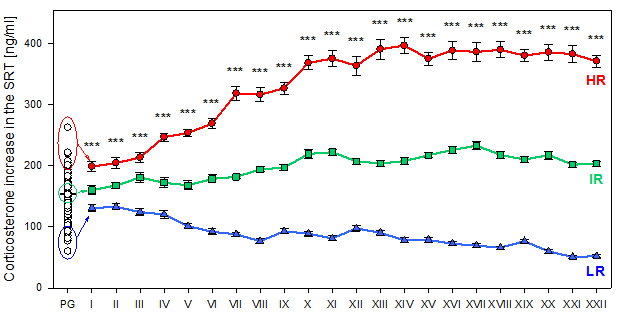Hauptinhalt
Topinformationen
Endophenotyping of mice selected for extremes in stress reactivity: the HR/IR/LR mouse model of affective disorders
Dysfunctions of the hypothalamic-pituitary-adrenal (HPA) axis are closely associated with the pathophysiology of affective disorders such as major depression (MD). Accordingly, patients suffering from MD frequently show profound neuroendocrine alterations with hyper- or hypo-cortisolism as a result of a dysregulated stress hormone system. Focusing on this key endophenotype of MD, a new genetic mouse model has been established in our group by applying a selective breeding approach in order to unravel the molecular mechanisms underlying increased versus decreased stress reactivity, including concomitant alterations in brain function.
Starting from a population of outbred CD-1 mice, two breeding lines were established according to the outcome of a ‘stress reactivity test’ (SRT) consisting of a 15-min restraint period and tail blood samplings immediately before and after exposure to the moderate psychological stressor. Mice showing a very high or a very low secretion of corticosterone in the SRT, i.e. animals expressing a hyper- or a hypo-reactivity of the HPA axis, were selected for the ‘high reactivity’ (HR) and the ‘low reactivity’ (LR) breeding line, respectively. Additionally, as a reference group, a third breeding line was established consisting of animals with an ‘intermediate reactivity’ (IR) in the SRT.
Already in the first generation, i.e. animals derived from breeding pairs selected from the parental generation, significant differences in the reactivity of the HPA axis between HR, IR, and LR mice were observed. Moreover, these differences were found across all subsequent generations and could be further increased by selective inbreeding (see Figure), strongly indicating a genetic basis of the respective phenotype.

Corticosterone increase in the ‘stress reactivity test’ (SRT) of male CD-1 mice (parental generation, PG) and descendent generations (I – XXII) of the high (HR), intermediate (IR), and low (LR) reactivity breeding lines. Data are given as individual values (PG) and means ± SEM (Generation I – XXII). Statistically significant differences between the three lines are indicated by asterisks.
Various experiments have been performed to characterize these three mouse lines, particularly addressing clinically relevant aspects and the expression of candidate genes in the brain.
Interestingly, the hyper- (HR) and hypo- (LR) reactivity to stressors in our mouse model are accompanied by alterations in emotional behaviour, vegetative functions (including rhythmicity and sleep architecture) and cognitive processes, revealing phenotypic similarities to patients suffering from MD, in particular, when the two subtypes of melancholic and atypical depression are considered. Morphometric and neurobiological findings also support this view. Moreover, the stable differences in stress reactivity are associated with a hyper- or hypo-responsiveness at all levels of the HPA axis (peripheral, central and regulatory functions), indicating profound differences in the activation and feedback regulation of this important neuroendocrine system.
Key findings of our in-depth analyses of the HR/IR/LR mouse model are summarized in this table.

Summary of endophenotypes observed in the ‘high reactivity’ (HR) and ‘low reactivity’ (LR) mouse lines, in relation to ‘intermediate reactivity’ (IR) animals.
The results gathered so far demonstrate that the stress reactivity mouse model shows functional alterations in many relevant parameters, revealing endophenotypes highly similar to those observed in MD patients, thus proving a high level of face and construct validity of the model.
Additionally, efforts are undertaken, including SNP analyses and sequencing of target genes, to investigate the genetic predisposition towards increased or decreased stress reactivity in more detail and to elucidate functional implications of different gene variants and their contribution to the observed endophenotypes. Ongoing studies using proteomic and microarray screening methods as well as pharmacological approaches will further supplement these data on the HR/IR/LR mouse lines with information regarding the molecular mechanisms and major players involved in bringing about the profound alterations in stress responsiveness and concomitant neurobiological changes resulting in disturbed brain function.
In conclusion, by selectively breeding mice for extremes in stress reactivity clinically relevant endophenotypes of MD can be modelled, presumably including the symptomatology and pathophysiology of specific subtypes of the disease. Given its unique strength as an experimental system for studying genetics, neurobiology, and behaviour, the stress reactivity mouse model can be central to meeting the challenge for cross-species translational research in biological psychiatry. Thus, the HR/IR/LR mouse lines are a highly valuable tool to significantly improve our understanding of the biological underpinnings and pathways involved in the aetiology of affective disorders, including the discovery/refinement of novel targets for drugs tailored to match specific pathologies.

